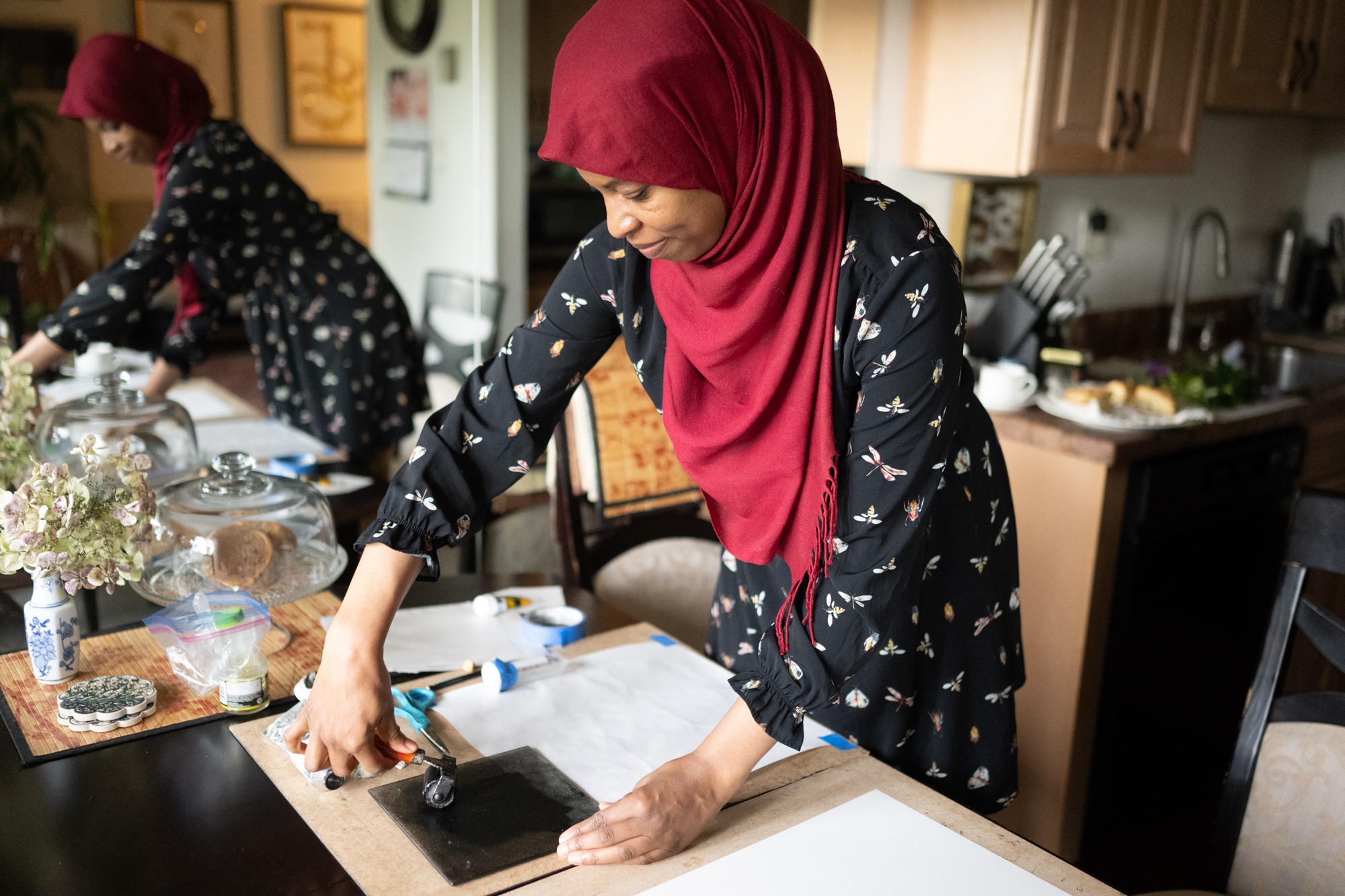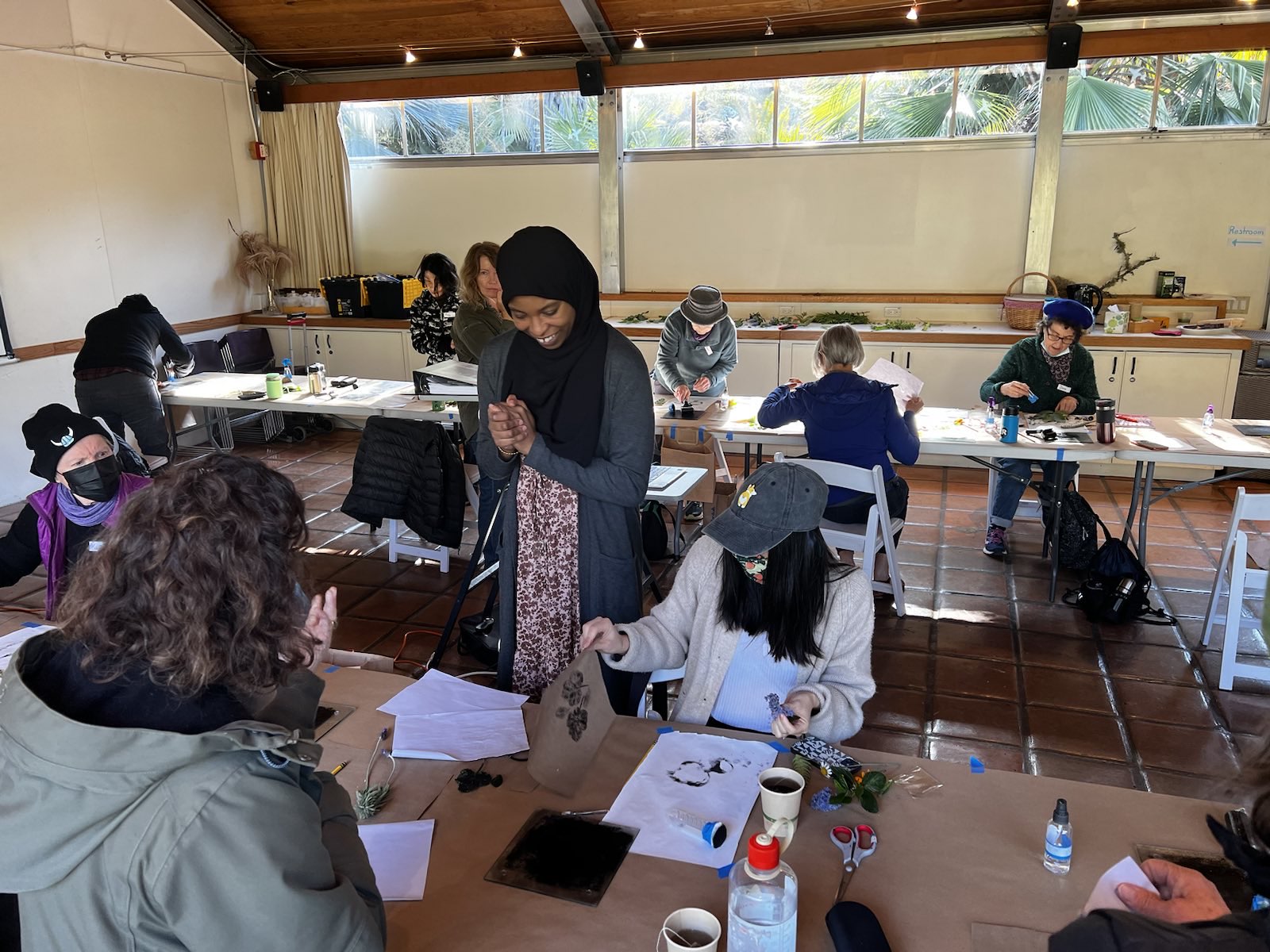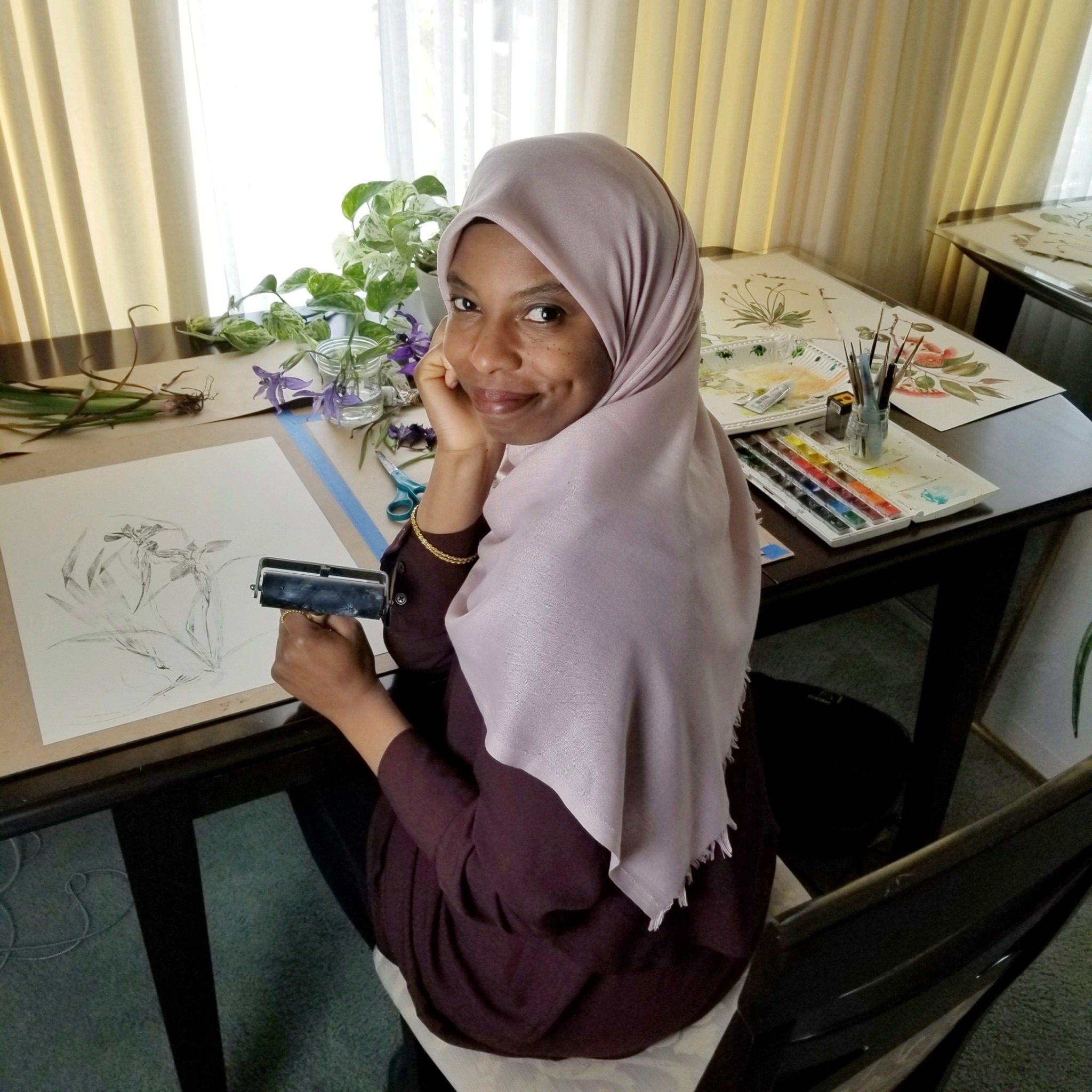We were lucky to catch up with Latifat Apatira recently and have shared our conversation below.
Latifat , appreciate you joining us today. How did you learn to do what you do? Knowing what you know now, what could you have done to speed up your learning process? What skills do you think were most essential? What obstacles stood in the way of learning more?
It all began with a moment of unexpected curiosity. I stumbled across a local catalogue advertising a workshop for something called botanical nature-printing. The featured image—a delicate print of a Queen Anne’s lace (Daucus carota) flower—stopped me in my tracks. I had always harbored a quiet love of plants and spent my youth capturing their beauty through photography and flower pressing. I marveled at pieces of botanical illustration, but my lack of drawing skills presented a significant hurdle—one I was convinced I couldn’t overcome. But, over the years, those creative impulses gave way to the “important” responsibilities of adulthood, education, and professional life. And so, many of my creative pursuits faded into the background.
When I saw that the workshop promised something beautiful—the chance to create antique-style botanical prints without the need to draw—I felt something click. Something just hit me. I knew I had to take the workshop. It seemed like a beautiful convergence of my past interests: the observational beauty of photography, the tactility of plant pressing, and the elegance of botanical illustration—all wrapped in a medium I had never seen or heard of before. And success was guaranteed without needing to draw. I signed up, not yet realizing it would ignite a deep and consuming creative practice that would become central to my identity.
Looking back, I now realize how much faster I could have developed as a botanical artist if I had given myself permission to take my work seriously from the start. I wish I had sought out formal instruction earlier, such as botanical illustration courses, mentorship, or even structured critiques. All of my progress came through trial and error: studying books, analyzing the works of artists I admired, and dipping into brief online classes. That method worked for me, but it was a slow, and at times painful process. However, it led to the development of an important non-technical skill—the mindset to experiment. The audacity to try, to mess up fantastically, and to try again is what allowed me to develop a personal style. Being self-taught, I realized how important it was to give myself permission to be surprised by what worked and what didn’t. It was through such experimentation that I ended up overcoming one of my oldest creative fears: drawing.
One of my favorite moments came when I was working on a print of Red Flowering Gum (Corymbia ficifolia), a plant with gorgeous, crimson firework flowers that mature into urn-shaped gumnuts. Using my style of nature-printing, the nuts weren’t printable, but I felt they needed to be in the final art piece. So, I sketched them in and watercolored them to create the illusion of a three-dimensional form. It sounds simple, but for me, that was huge. I had always told myself I couldn’t draw. And suddenly, there I was, drawing a life-like object. That’s when things really opened up. Now, it’s not unusual for my pieces to include a mix of printed textures and hand-drawn elements like fruit and bark, plant parts that don’t print well. That mix, that tension between what can be pressed and what must be drawn, has become part of my botanical art creative voice.
Time, though, that’s been my biggest obstacle. For years, I was working full-time as a physician. And while that identity was important and consuming, something I spent over a decade training for, it left little room for creativity. My artwork was squeezed into late nights and leftover weekend moments. I kept telling myself I couldn’t, that I shouldn’t prioritize art, because medicine came first. But the more I created, the more I realized that my creative side wasn’t some hobby, but was integral to who I am. And not having room for my creativity grew increasingly frustrating. Eventually, I made the difficult decision to reduce my clinical hours. It felt risky, and ask anyone who knows me, I’m a risk-averse person. I was terrified of disappointing others, of financial instability, of failing. But it turned out to be one of the best decisions I’ve ever made. It provided a more expansive slice of time where I could nurture my creative identity and live a more integrated, balanced life—one where the scientific and the creative, the structured and the spontaneous, could coexist. And now from that place of wholeness, my best work continues to grow.

Awesome – so before we get into the rest of our questions, can you briefly introduce yourself to our readers.
I’m a botanical nature-printmaker and, until very recently, was based in the San Francisco Bay Area. In April 2025, I moved to Dallas, Texas and am looking forward to continuing my creative journey here. I learned about botanical nature printing unexpectedly when I took a workshop that introduced me to this centuries-old monoprinting technique. Using fresh plants, ink, and the pressure of my hands, nature printing creates life-sized impressions of flora, blending art, science, and history.
Botanical nature printing was once used as a functional tool by botanists and physicians to document medicinal and exotic plants, but the process has since evolved into a medium of artistic expression. I build on that tradition by enhancing my prints with watercolor and illustration, merging observational precision with creative interpretation. With nature printing, plants and I tell stories—about identity, about wonder.
I create original hand-printed and illustrated botanical artwork, sell fine art prints, exhibit in galleries and museums, and lead hands-on workshops. What makes my work a little different is the way it weaves together all the parts of who I am. I’m a physician, an artist, a Muslim woman, a Nigerian-American, a plant lover, an educator, and someone who’s still learning. My creative practice integrates faith, spirituality, science, and storytelling through plants. Through this work, I collaborate with the community to (re)connect with the botanical world and (re)consider our relationship to it.
My mission is not just to create a beautiful print, but to awaken what I call “plant attention” in an urban culture where plants are often considered background greenery rather than the vital organisms upon which we all rely for life.
What I’m most proud of is how my art encourages reverence for the Creator of the botanical world. Before I discovered nature printing, I enjoyed the beauty of plants, but didn’t know them as individuals, I didn’t know their names, their unique qualities or characteristics. But my creative practice transformed me. Now, I work to combat botanical cultural and ecological disconnection by showing how intimately we are linked to plant life. Each print I create is a quiet act of resistance to indifference—a way of saying that plants matter deeply and deserve not only our attention but our admiration and protection. In a world where plants are often treated as mere background decoration or landscaping, my work invites people to pause, experience, and wonder.

Learning and unlearning are both critical parts of growth – can you share a story of a time when you had to unlearn a lesson?
A lesson I’ve had to unlearn, and am still unlearning, is self-doubt. It’s been one of the hardest parts of becoming an artist later in life. I didn’t grow up thinking of myself as someone who would exhibit work in galleries or teach creative workshops. I became a physician, and for years, I dedicated myself to science, structure, and service.
When I started making botanical prints, I felt like I was stepping into a world I didn’t quite belong in. What’s worse, I found myself constantly comparing my early efforts to artists who had been creating for decades. Sometimes, I’d look at artists I admired—people who’ve been making work all their lives—and think, Who am I to even try?
This comparison game slowed me down. It still does. It’s a work in progress. What I’ve come to realize is that the hardest part of my creative process wasn’t learning printing techniques—it was learning to believe in myself as an artist. I’ve had to consciously resist the inner voice that says, You’re too late, or You’re not good enough. But now, when those thoughts creep in, I remind myself: I just started this journey a few years ago. And before that, I was busy building another kind of meaningful life.
I now try to meet myself where I am—with honesty, compassion, and a little courage. It’s been humbling to realize that growth in art isn’t linear, and that confidence, like any skill, takes time and practice. My story didn’t begin in art school or childhood sketchbooks, it began with medicine, curiosity, and a rediscovery of awe through plants. That history doesn’t make me less of an artist, but rather I feel it makes my work more layered and personal.

What’s the most rewarding aspect of being a creative in your experience?
The most rewarding aspect of being an artist is the opportunity to witness transformation—both in others and in myself. Through botanical nature printing, I’ve seen people learn to appreciate plants in ways they never expected. In every workshop I’ve taught, I have the honor to watch someone press a leaf for the first time and suddenly see it differently. That moment when something ordinary becomes extraordinary—when a fallen leaf, or a fresh flower becomes a living structure full of texture, intelligence, and beauty, when someone’s attention shifts and awe returns—that’s what makes my work deeply meaningful. And a privilege.
For me, creating botanical art has awakened a long-dormant part of myself. It has expanded how I understand healing, attention, and presence. I’ve changed how I see myself as an individual too. I now carry both parts of my identity, scientist and artist, observer and maker, in a more integrated and truthful way. A way that has brought me, and continues to bring me, incredible contentment and joy.
Contact Info:
- Website: https://www.titilayola.com
- Instagram: https://www.instagram.com/titilayola/?hl=en




Image Credits
Images LA1, LA2, LA3, LA4, LA5: Stephanie Penn


